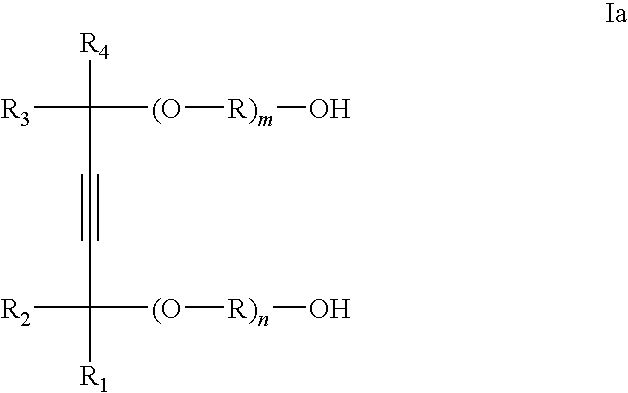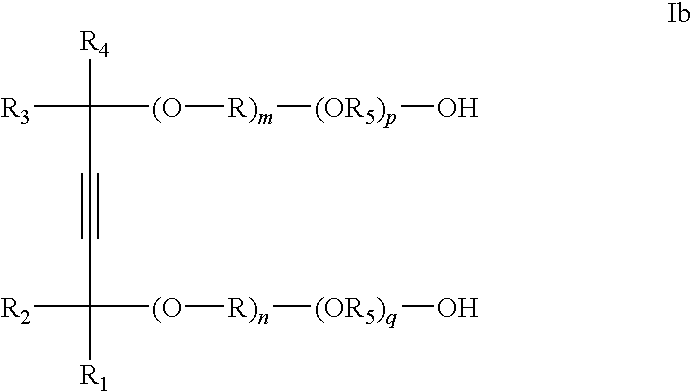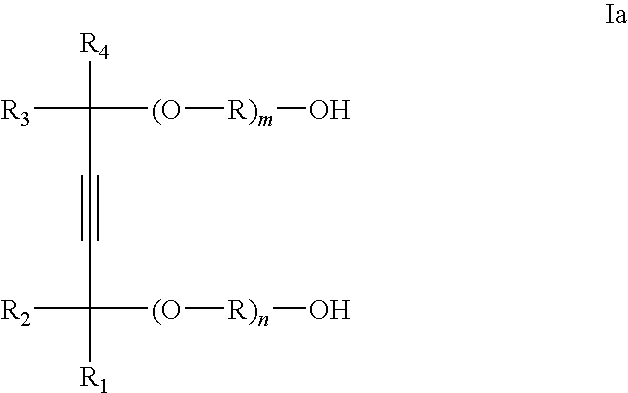Separatory and emulsion breaking processes
a technology of emulsion and separation process, applied in separation process, other chemical processes, borehole/well accessories, etc., can solve the problems of residual product contamination, abrasion, erosion, etc., and damage to the refinery tower tray and other equipmen
- Summary
- Abstract
- Description
- Claims
- Application Information
AI Technical Summary
Benefits of technology
Problems solved by technology
Method used
Image
Examples
example 1
[0050]97 ml of crude oil along with 3 ml of D.I. water were admitted to each test cell along with the candidate emulsion breaker materials. The crude / water / treatment mixtures were homogenized by mixing each of the test cell tubes at 13,000 rpm for 2 seconds. The test cell tubes were heated to about 250° F. Water drop (i.e., water level) in ml was observed for each sample after the predetermined time intervals according to the schedule. Results are shown in Table 1.
[0051]
TABLE 1Treatmentppm1 min2 min4 min8 min16 min32 min64 minSumI / FBlank0000.10.10.20.20.20.8.4 IF10.500.20.40.81.622.257.251200.20.81.422.52.59.41500.11.41.82.83312.111000.10.81.62.42.5310.42W1571000.40.611.825.82W1575001.41.6233112W157100011.422.52.59.4Blank000.20.811.4227.4.3 IF10.500.22.2344518.41200.12.544.55521.11500.11.833.544.516.911000.21.422.533.512.62W157100.2233.544.517.22W157500.22.53.54.55520.72W1571000.22.5444.54.519.7Blank000.2122.53412.70.3P-84500.41.4233.5515.32500.433.544.5520.45500.433.53.54519.40.535...
example 2
[0052]Another series of tests was performed using the simulated desalter apparatus described in Example 1. In this series of test, 95 ml of crude oil and 5 ml of D.I. water plus treatment were added to the test cells. Results are shown in Table 2.
[0053]
TABLE 2Treatmentppm1 min2 min4 min8 min16 min32 minSumBlank000.21.422.54.510.62W15750234.55519.56500.422.52.5310.4P-845012.534515.52502.54.54.85521.8Treatment 6 = (TMDD-5)-
example 3
[0054]Another test series was undertaken to assess the efficacy of candidate materials in breaking bitumen emulsions. These tests were similar to those reported in Example 1 with exceptions noted in the table and the fact that an electrical field was not imparted to the test emulsions. Results are reported in Table 3.
[0055]
TABLE 3Ratio of bitumen emulsion to diluent 80%::20%Conditions: Blended at 10,000 rpm for THREE secondsGrids offAmount of emulsion remaining afterDiluent + mLTreatmentppm1 min2 min4 min8 min16 min32 minsumOil recoveredBlank080808080808048002W157500505050505050300180 7500454848505050291189 850080808060706543545 950053535452545432016010500808080607063433471150050505050555831316712500454747474747280200
Without treatment, the bitumen emulsion was completely unbroken under the conditions used.[0056]Treatment 7=combination of a) TMDD-5 and b) PEO / PPO block copolymer, PEO=40 molar %; mw≈4,000; a) is present in amount of 5 wt %; remainder b)[0057]Treatment 8=combination of...
PUM
| Property | Measurement | Unit |
|---|---|---|
| temperature | aaaaa | aaaaa |
| weight | aaaaa | aaaaa |
| corrosion | aaaaa | aaaaa |
Abstract
Description
Claims
Application Information
 Login to View More
Login to View More - R&D
- Intellectual Property
- Life Sciences
- Materials
- Tech Scout
- Unparalleled Data Quality
- Higher Quality Content
- 60% Fewer Hallucinations
Browse by: Latest US Patents, China's latest patents, Technical Efficacy Thesaurus, Application Domain, Technology Topic, Popular Technical Reports.
© 2025 PatSnap. All rights reserved.Legal|Privacy policy|Modern Slavery Act Transparency Statement|Sitemap|About US| Contact US: help@patsnap.com



